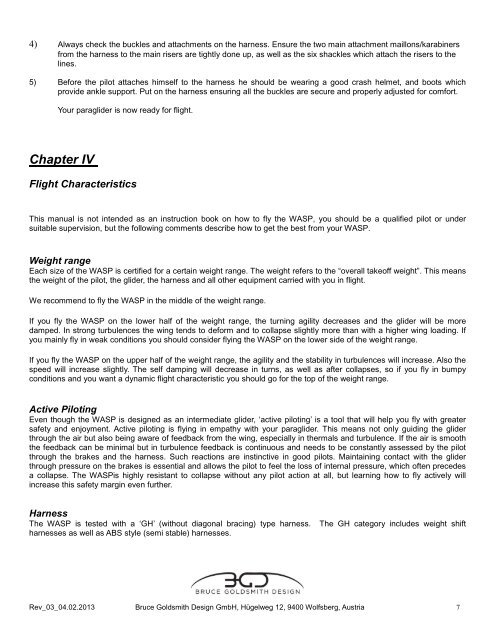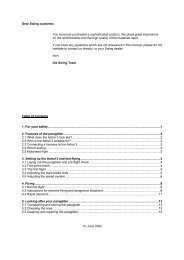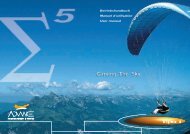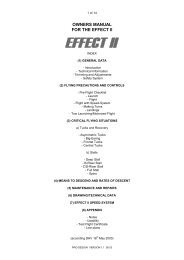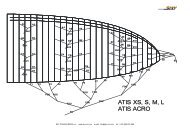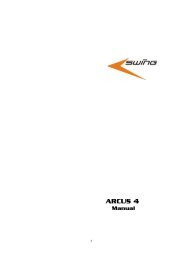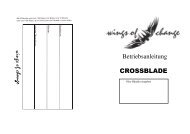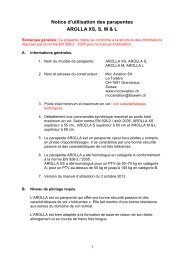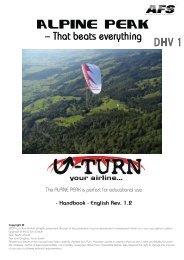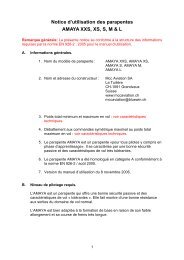Wasp - Manuel d'utilisation - Bruce Goldsmith Design
Wasp - Manuel d'utilisation - Bruce Goldsmith Design
Wasp - Manuel d'utilisation - Bruce Goldsmith Design
Erfolgreiche ePaper selbst erstellen
Machen Sie aus Ihren PDF Publikationen ein blätterbares Flipbook mit unserer einzigartigen Google optimierten e-Paper Software.
4) Always check the buckles and attachments on the harness. Ensure the two main attachment maillons/karabiners<br />
from the harness to the main risers are tightly done up, as well as the six shackles which attach the risers to the<br />
lines.<br />
5) Before the pilot attaches himself to the harness he should be wearing a good crash helmet, and boots which<br />
provide ankle support. Put on the harness ensuring all the buckles are secure and properly adjusted for comfort.<br />
Your paraglider is now ready for flight.<br />
Chapter IV<br />
Flight Characteristics<br />
This manual is not intended as an instruction book on how to fly the WASP, you should be a qualified pilot or under<br />
suitable supervision, but the following comments describe how to get the best from your WASP.<br />
Weight range<br />
Each size of the WASP is certified for a certain weight range. The weight refers to the “overall takeoff weight”. This means<br />
the weight of the pilot, the glider, the harness and all other equipment carried with you in flight.<br />
We recommend to fly the WASP in the middle of the weight range.<br />
If you fly the WASP on the lower half of the weight range, the turning agility decreases and the glider will be more<br />
damped. In strong turbulences the wing tends to deform and to collapse slightly more than with a higher wing loading. If<br />
you mainly fly in weak conditions you should consider flying the WASP on the lower side of the weight range.<br />
If you fly the WASP on the upper half of the weight range, the agility and the stability in turbulences will increase. Also the<br />
speed will increase slightly. The self damping will decrease in turns, as well as after collapses, so if you fly in bumpy<br />
conditions and you want a dynamic flight characteristic you should go for the top of the weight range.<br />
Active Piloting<br />
Even though the WASP is designed as an intermediate glider, ‘active piloting’ is a tool that will help you fly with greater<br />
safety and enjoyment. Active piloting is flying in empathy with your paraglider. This means not only guiding the glider<br />
through the air but also being aware of feedback from the wing, especially in thermals and turbulence. If the air is smooth<br />
the feedback can be minimal but in turbulence feedback is continuous and needs to be constantly assessed by the pilot<br />
through the brakes and the harness. Such reactions are instinctive in good pilots. Maintaining contact with the glider<br />
through pressure on the brakes is essential and allows the pilot to feel the loss of internal pressure, which often precedes<br />
a collapse. The WASPis highly resistant to collapse without any pilot action at all, but learning how to fly actively will<br />
increase this safety margin even further.<br />
Harness<br />
The WASP is tested with a ‘GH’ (without diagonal bracing) type harness.<br />
harnesses as well as ABS style (semi stable) harnesses.<br />
The GH category includes weight shift<br />
Rev_03_04.02.2013 <strong>Bruce</strong> <strong>Goldsmith</strong> <strong>Design</strong> GmbH, Hügelweg 12, 9400 Wolfsberg, Austria 7


